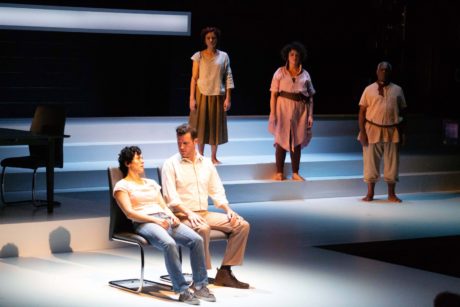The latest data from the Child Welfare League of America indicate that in Maryland in 2015, there were over 51,000 referrals for child abuse and neglect. Of those, nearly 21,000 reports were referred for investigation. And of that number, there were 6,790 victims of abuse or neglect in Maryland, a rate of 5.0 per 1,000 children. Of these children, about 59% were neglected, 23% were physically abused, and nearly 24% were sexually abused.

What staggering numbers.
And How I Learned to Drive’s Li’l Bit might have been one if the case had been reported to the government agency as required by law. Then again, it wasn’t until 1974, after the events depicted in Paula Vogel’s fictional How I Learned to Drive, that there was even a federal statute called the Child Abuse Prevention and Treatment Act that required states to take certain actions.
So why does this data background matter in this column about Round House’s excellent production of How I Learned to Drive (reviewed by DCMTA’s Amy Kotkin here)? It is a way to grasp the continuing extent of child sexual abuse. And the data is only cases reported to a government agency. Some research suggests that there is a disproportionate number of child sexual abuse cases reported to Child Protective Services that come from lower socioeconomic classes. But the issue of child abuse and neglect does not only affect the lower socioeconomic classes. All of this is important to appreciate the issues raised by playwright Vogel’s How I Learned to Drive and bring them beyond the walls of a theater and its limited number of theatergoers.
In my own professional career, including a stint with the Maryland Department of Human Resources, I had come to know another phrase for Li’l Bit’s driving lessons with her Uncle Peck. In the field, it was called “grooming,” the word for the manner in which a perpetrator slowly built a relationship of friendship and trust with a young person. The perpetrator can be someone that the family might have some unease about, as does Li’l Bit’s mother in How I Learned to Drive.
With grooming, an individual might give driving lessons, or provide special gifts or perhaps a pet or something dear to a child–and then threaten to stop providing such attention or gifts if the intended victim does not voluntarily do as expected.
As with Uncle Peck, grooming is a tactic of giving a victim a sense of control over life, even when under the soft assault by the trusted adult.
When I first encountered How I Learned to Drive at Arena Stage in 1999, I reacted to it as both a theatergoer and as one working in the human services field. The play had recently won the Pulitzer and Artistic Director Molly Smith brought it to Arena. I recall how it shook the audience and reviewers alike such as the Washington Post lead reviewer at the time.
At the Arena production nearly 20 years ago, I appreciated a need for distance between the play’s dark, unforgiving topic and the audience so the audience would take the ride they likely would not normally seek to take. Is that still the case, I wondered?

What I also recall from two decades ago were reactions of theatergoers that the play was not about them, the audience. It was not universal, so they thought, but about “other” people. People far away. People from a county with lower socioeconomic status. Not people from, say, Potomac or McLean. But rather about folk with accents or without education. After all, people of privilege would never do such things.
Now twenty years later, How I Learned to Drive meets the current times in America. Uncle Peck is still in the rearview mirror. But, now what will an audience of men and women, the high status 1% and those in other social classes or all races make of it? Might today’s audiences think the play more universal in its subject matter? I wish I had an answer. The final scenes of How I Learned to Drive remain still unsettling and powerful. Uncle Peck remains in Li’l Bit’s rearview mirror as she drives along.
What also strikes me still is Li’l Bit’s line about her Uncle Peck: “Who did it to you, Uncle Peck? How old were you? Were you eleven?” Vogel’s non-full-frontal attack is searing. In the field, it would be a question likely asked.
How I Learned to Drive is uncompromising and provides no easy black and white. That makes it so disquieting. With its back-and-forth in time, Vogel provides the audience with a breather and time to ponder the horrors they witness.
Who and what would Li’l Bit be now in 2018? I have no clue. She might be in the Round House audience right now. One thing that hit me harder this time around, was the power that Li’l Bit took back in her fictional life when she finally said “no” to Uncle Peck. She was powerful. As for Li’l Bit, I guess we each decide what happened to her down her long road of living.
Running time: One hour and 40 minutes. with no intermission.
How I Learned To Drive plays through November 4, 2018, at Round House Theatre – 4545 East-West Highway, in Bethesda, MD. For tickets, call the box office at 240-644-1100, or purchase them online.




